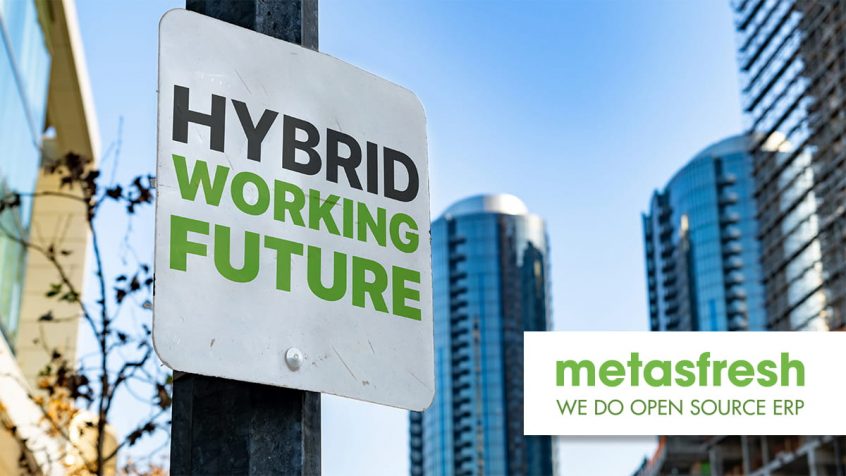Share this Post
Once upon a time, a little over a year ago, the office was something we all took for granted. Five days a week, we woke up, commuted into towns and cities to attend our jobs and sit behind desks in offices. We had formal meetings in the meeting room, and informal meetings by the water cooler. We shook hands, high-fived and shared food without a second thought. We had good days, bad days, and many, many ordinary office days. The office, indeed, was an everyday staple of modern working life.
Then, 2020 happened — and our everyday working lives were changed beyond all recognition, pretty much overnight. Office buildings around the globe closed their doors, and the biggest work from home experiment in history began. Employees set up workstations on the kitchen table, in their bedrooms, in the spare room in the attic. Handshakes and high fives were replaced with emojis and emoticons on instant messaging tools. Meetings took place via Zoom, MS Teams and Google Meet. Lunches were eaten alone.
It’s been a long year — long enough, in fact, for the changes we’ve all had to make as a result of the COVID-19 emergency to alter our perspective on the office, our daily commutes, and what a work/life balance really means. The result is that the workplace may never be the same again. Indeed, rather than mourn the loss of office-centricity, employees and employers alike have adjusted to the new way of working remarkably well — and for many, the results of the remote working experiment have been better than imagined.
The End of Office-Centricity?
Once believed critical to productivity, culture building, employee engagement, and talent acquisition, for decades, companies have competed for prime office space in city centres around the world. However, studies have revealed that, during the pandemic, many people have been surprised at how quickly and effectively digital communication, collaboration and business management technologies like cloud-based ERP solutions have been adopted to ensure business continuity – and in many cases, productivity, engagement and sense of well-being have in fact been improved.
A January 2021 study from PwC reveals that both employees (71%) and employers (83%) have found remote work to be a success throughout the pandemic.
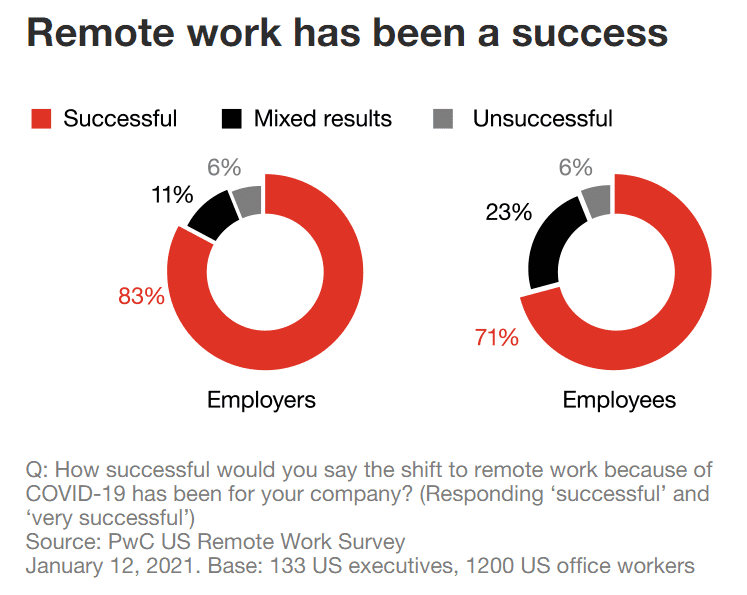
The shift to remote work because of COVID-19 has been a success. —Source: pwc.com
In fact, the majority of employers have found that performance has either remained the same or improved under remote work in a number of areas, including new project collaboration, securing new customer relationships, coaching employees, and onboarding new hires.
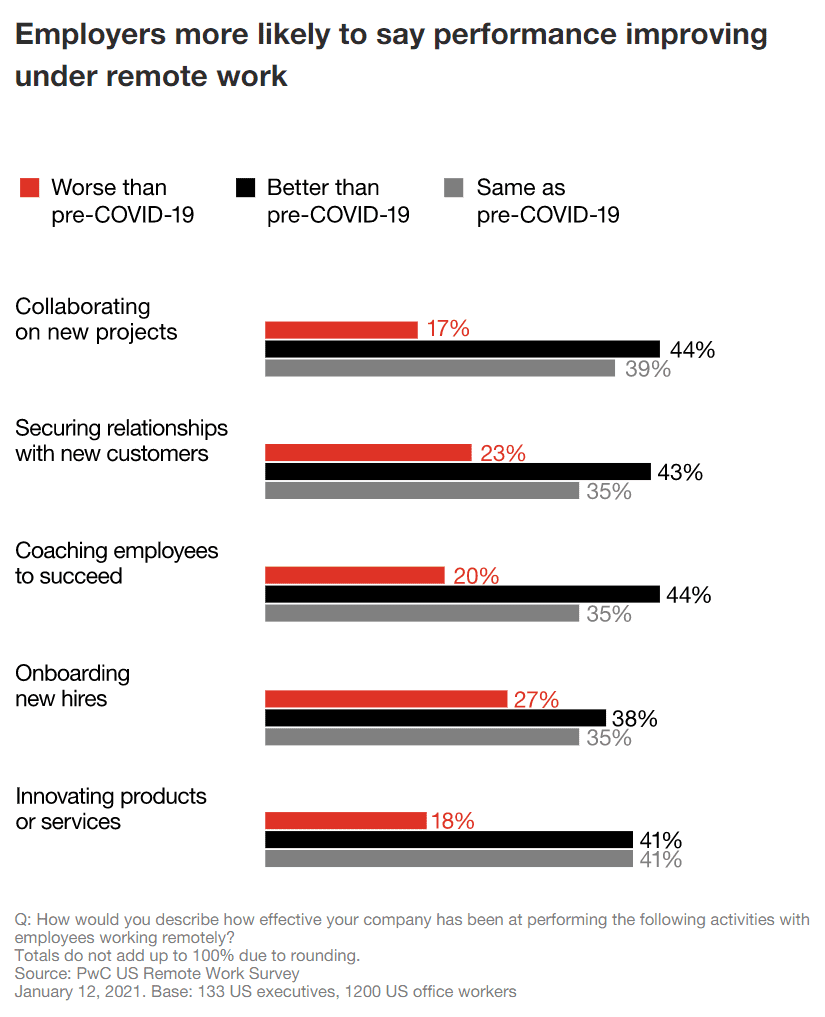
Effectiveness of activities performed with employees working remotely. —Source: pwc.com
Over 80% of employees, meanwhile, say they would prefer to remain remote at least one day a week once pandemic concerns recede — and over half (55%) would like to continue working remotely at least three days a week indefinitely.
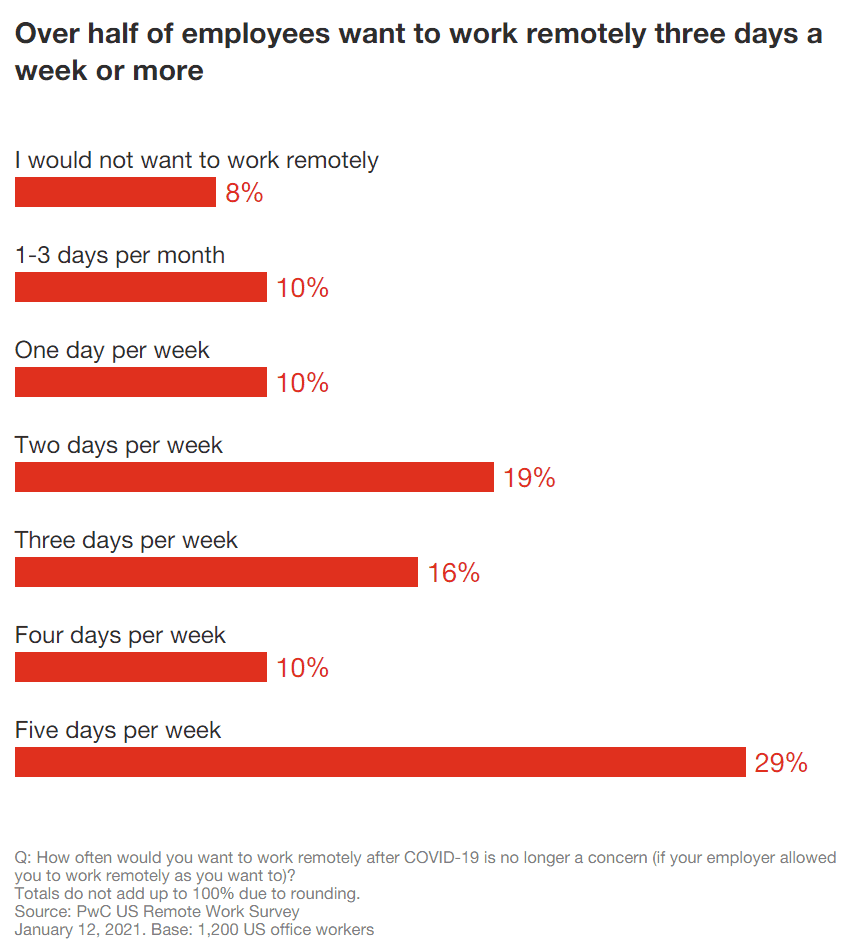
Preferences regarding remote work frequency after COVID-19. —Source: pwc.com
New Preference for Hybrid Working Emerges
Other studies reveal a similar attitude shift towards long-term remote working — however, those who want to work exclusively at home and never come into the office again are in the minority. Less than one-third (29%) of PwC’s survey respondents want to continue working at home five days a week, while the Gensler UK Workplace Survey found that only 12% of UK office workers would be happy working from home full time. In Germany, the figure stands at 21%, according to a survey from digital consultancy Publicis Sapient, while 20% favour working from home every day in Italy, and 14% in France.
While precise figures vary slightly, what’s revealed across nearly all surveys is a majority of roughly two-thirds that now favour a hybrid work model — where employees can work from home 1-4 days a week and go into the office on the remaining days.
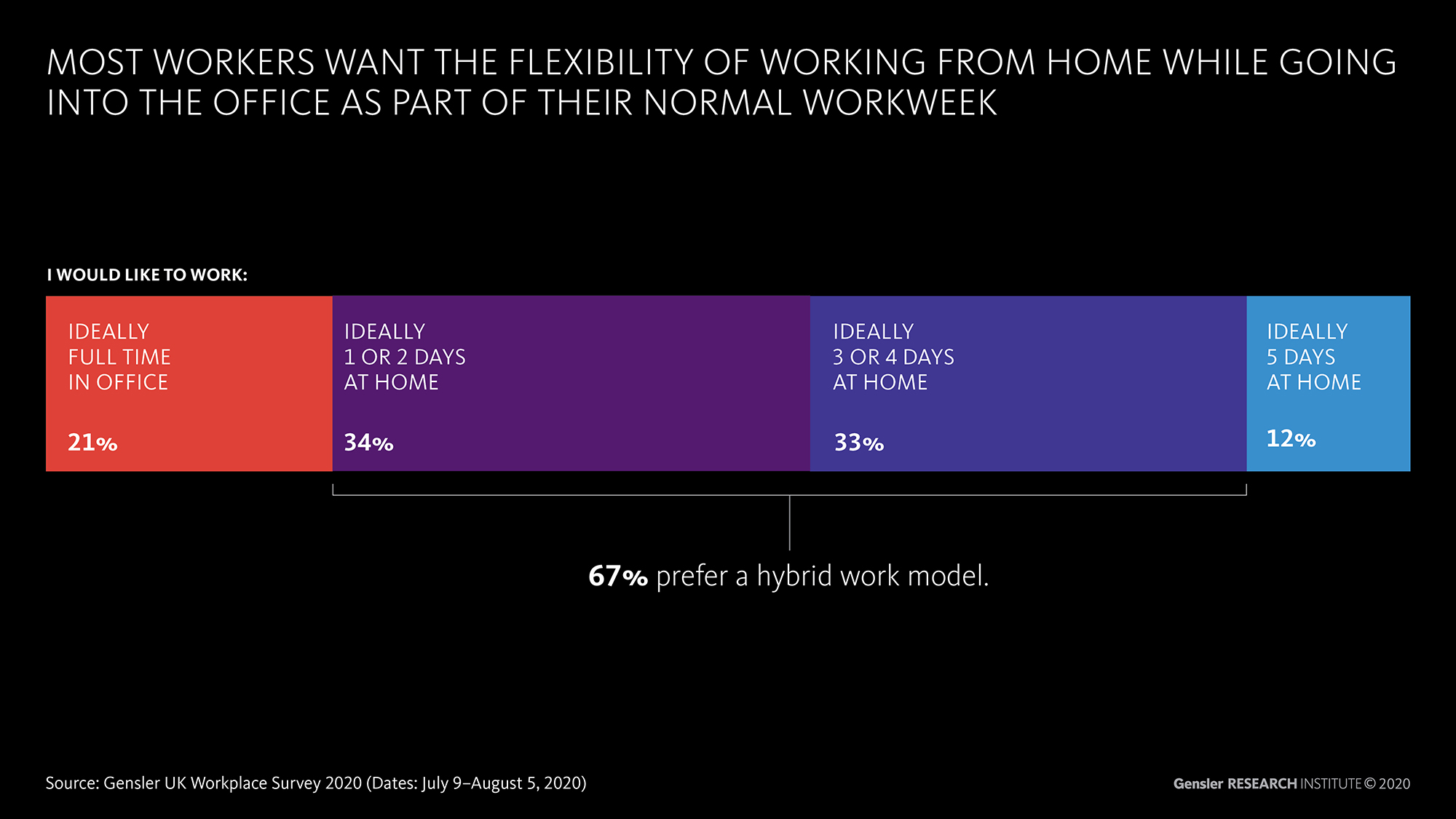
Over two-thirds of the UK workforce would prefer a hybrid work model. —Source: gensler.com
The question is, however, is this possible?
McKinsey & Company wanted to find out. To determine how extensively remote work might persist after the pandemic, McKinsey analysed its potential across more than 2,000 tasks used in roughly 800 occupations across eight countries for the Future of Work After COVID-19 report, published in February 2021. It considered only remote work that can be done without a loss of productivity and found that about 20% to 25% of workforces in advanced economies could work from home between three and five days a week.
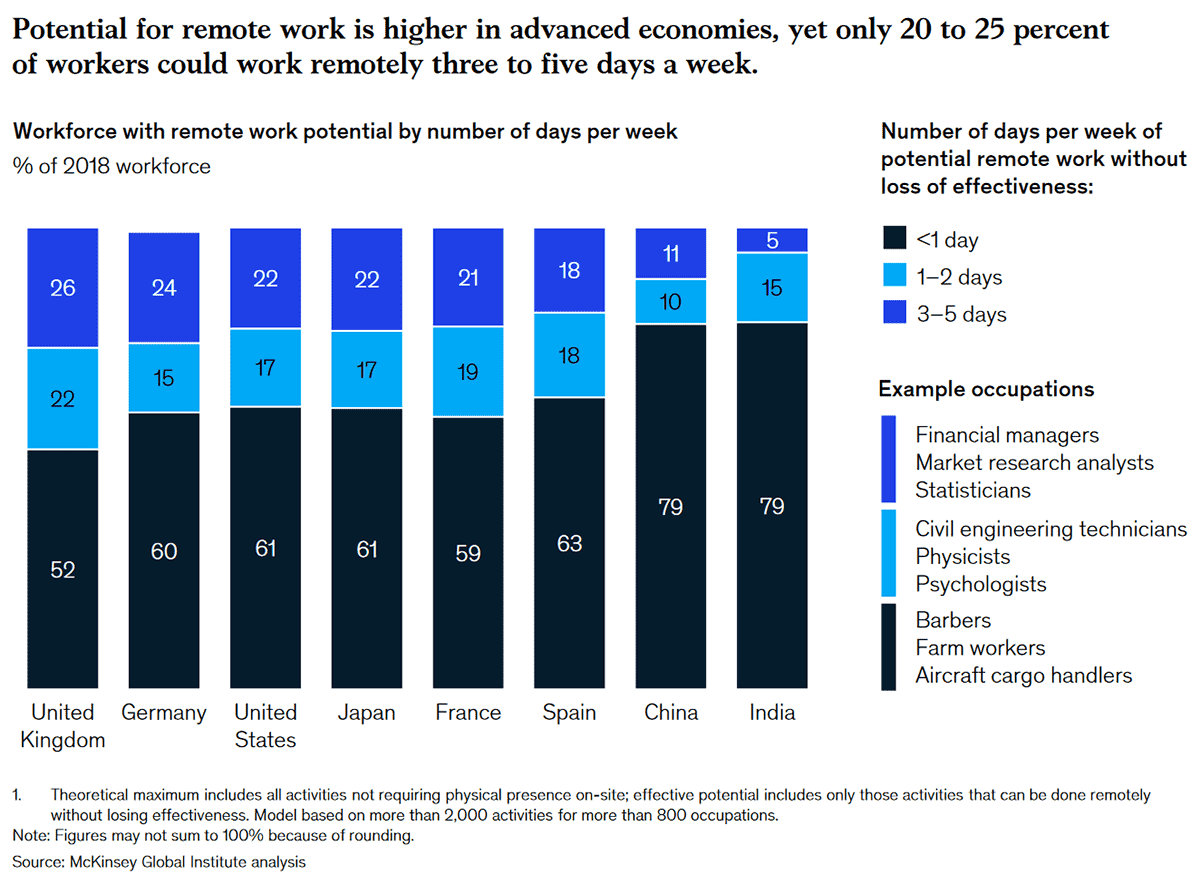
Workforce with remote work potential by number of days per week. —Source: mckinsey.com
This represents four to five times more remote work than before the pandemic, McKinsey says. Some companies are already executing plans to shift to flexible workspaces, following positive experiences with remote work over the past twelve months — a move that will reduce the overall physical space these companies need and bring fewer workers into the office each day. On average, according to a survey of nearly 300 executives by McKinsey, companies are planning to reduce office space by 30%.
Cloud ERP — A Must for Hybrid Working Models
Considering the results from numerous global surveys, it seems that the overall rate of home working will be higher after the pandemic with companies relying less on physical office in the future. This will likely be great news for those who face a long commute or find that they really are as — or more — engaged and productive at home. However, as the surveys show, there are many for whom home working all the time isn’t the answer. Some people don’t have the space for a home office. Others, perhaps with young children, family or roommates at home, find they have too many distractions. And still more who live on their own can find remote work lonely and demotivating.

Preferences regarding going into an office and working from home —Source: consultancy.uk
As such, in order to attract and retain the best talent, and to keep the workforce connected, organised, engaged, motivated and productive, companies must now invest in the tools and technologies that enable a flexible or hybrid working model. Indeed, while the need for physical office space looks set to decrease for the long-term, the need for virtual office space will, naturally, increase in kind.
For many companies, this will require the continued deployment of cloud-based digital business solutions — powerful communication, collaboration and data sharing tools like metasfresh Cloud ERP that keep employees connected with each other, as well as with external customers, suppliers and partners, no matter where they are.
The beauty of a cloud-based ERP system like metasfresh is that it is accessible from anywhere. Functioning as the central nervous system of the business, metasfresh Cloud ERP is an overarching business information and process management tool that centralises all company data and makes it instantly available to all departments on any device from anywhere with an internet connection — be it at home or at the office.
With deep integration with other business applications and tools — such as your CRM, email marketing software, accounting and HR solutions, and more — metasfresh Cloud ERP gives all team members across all departments the necessary means to communicate, collaborate and do their jobs effectively whether working remotely or in the office.
Whether you plan to go fully remote or embrace a hybrid working model, the long-term changes required necessitate transformational thinking. Ultimately, the aim is to create a safe, collaborative and productive environment where employees can work together with their colleagues and achieve the objectives of the organisation. To create such an environment that spans a distributed workforce, a fully integrated, cloud-based and all-embracing business management system is essential.
Talk to us here at metasfresh to learn more about how metasfresh Cloud ERP can empower your workforce of the future. Since 2006 we have been developing our ERP software non-stop with open source components and under the open source licences GPLv2 and GPLv3. Our mission is to enable each and every company to access a powerful ERP system that supports digital transformation and fuels corporate growth. Get in touch today for more information and insights.
Share this Post



